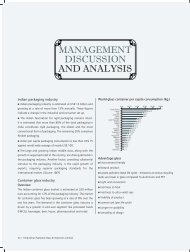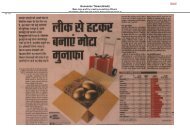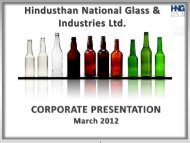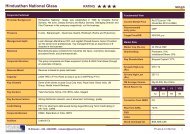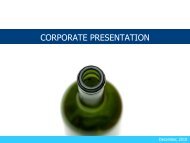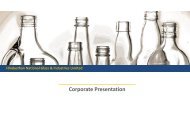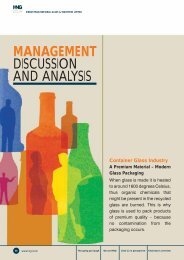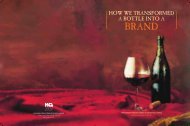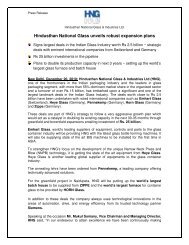906Annual Report 2008-09.pdf - Hindusthan National Glass ...
906Annual Report 2008-09.pdf - Hindusthan National Glass ...
906Annual Report 2008-09.pdf - Hindusthan National Glass ...
Create successful ePaper yourself
Turn your PDF publications into a flip-book with our unique Google optimized e-Paper software.
The recycling loop<br />
<strong>Glass</strong> recycling<br />
Save energy in manufacturing for each tonne of cullet<br />
(recyclable glass) used, energy consumption is reduced by 2.5%<br />
Reduces emissions (including CO 2 )<br />
Preserves raw materials and landscapes<br />
Each tonne of cullet used means<br />
1 tonne less of land fill<br />
Over 1 tonne less of natural resources depletion<br />
Growth drivers<br />
Growing food processing industry<br />
The Indian food market, according to the 'India Food <strong>Report</strong><br />
<strong>2008</strong>', is estimated at over US$ 182 billion, and accounts for<br />
about two thirds of the total Indian retail market. Further,<br />
according to consultancy firm McKinsey, the retail food sector in<br />
India, is likely to grow from around US$ 70 billion in <strong>2008</strong> to<br />
US$ 150 billion by 2025, accounting for a large chunk of the<br />
world food industry. This would grow from US$ 175 billion to<br />
US$ 400 billion by 2025, driving the demand for packaging<br />
alternatives, especially glass containers. [Source: IBEF]<br />
Increasing rural consumption<br />
The FMCG industry in India was worth around US$ 16. 03 billion<br />
as on August <strong>2008</strong>, and the rural market accounted for a robust<br />
57% share of the total FMCG market in India, overtaking the<br />
urban market (43%). The rural per capita consumption of<br />
FMCGs would equal to current urban levels by 2017. Industry<br />
analysts also expect the FMCG sector in rural areas to grow 40%<br />
against 25% in urban. [Source: IBEF]<br />
Growing beer consumption<br />
The Indian beer industry has been witnessing steady growth of<br />
7-9% per year over the last 10 years. The rate of growth<br />
remained steady in recent years, with volumes passing from<br />
mere 70 million cases in 2002 to 155 million cases in <strong>2008</strong>. The<br />
Indian beer market is dominated by strong beers (>5% alcohol<br />
by volume), which accounts for 70% of the total beer industry.<br />
The premium beer market is a mere 5% of the total but this<br />
segment is rapidly expanding, touching a growth rate between<br />
35-40%. As a result, the demand for container bottle will surge.<br />
[Source: All India Brewers’ Association]<br />
Outlook<br />
The Indian economy is projected to achieve a sustainable GDP<br />
growth of around 6.5% whereas the annual growth of the<br />
packaging industry is expected to double to around 20-25%.<br />
The container glass industry, which grew at a compounded<br />
annual growth rate (CAGR) of 8% over five years, is expected to<br />
grow over 8% in the future. [Source: IBEF]<br />
The demand for container glass will grow on account of the<br />
forecasts that packaging material for beverages will mainly be of<br />
glass, especially for high quality packaging. <strong>Glass</strong> container plants<br />
will improve technology levels to produce thin and light-weighted<br />
bottles. Beer bottles should be made in more specifications,<br />
meeting the demands of customers at various levels. Based on<br />
the analysis of the current market demands at home and abroad,<br />
tubular vials for antibiotic use will increase gradually, although<br />
injection vials will still remain in the greatest demand.<br />
Business driver – 1<br />
Raw material resource management<br />
At HNG, corporate sustainability is derived from an ability to<br />
steady raw material cost structures across various market cycles<br />
either by tying up with new vendors or through acquiring lease<br />
rights. The Company’s principal raw materials comprises sand<br />
(quartz), limestone (calcite), cullet (broken recyclable glass), soda<br />
ash, dolomite and feldspar. Soda ash prices constituted 49<br />
percent of the total raw material cost (value wise), followed by<br />
cullet (25 percent), sand (12 percent) and other raw material<br />
(14 percent). The Company’s priority in this regard continued<br />
an emphasis on modest raw material cost combined with<br />
anytime availability leading to efficient, uninterrupted<br />
<strong>Hindusthan</strong> <strong>National</strong> <strong>Glass</strong> & Industries Limited | 33



